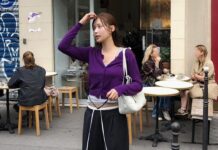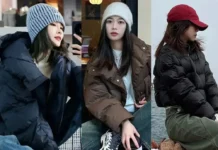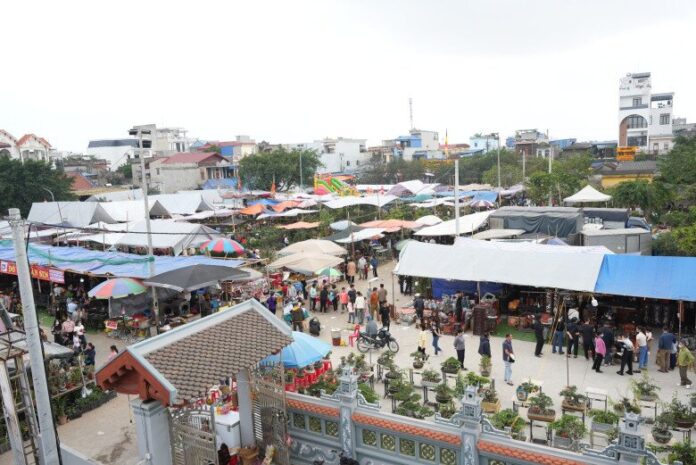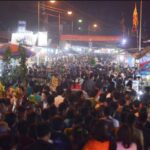This market is a unique representation of the traditional Northern Vietnamese village fairs, where agricultural tools and seedlings are sold at the beginning of the year. The fair only takes place on the night of the 7th and the morning of the 8th of the first lunar month. Vieeng Fair is held in a vast space, stretching from Goi town through Kim Thai commune to Trung Thanh commune in Vu Ban district. The center of the market is located around the architectural complex of Phu Chinh Tien Huong relic site in Kim Thai commune.

During the main Tet festival, the artistic flower and plant stalls stretch for tens of kilometers, from Phu Day to Goi town. This year’s fair attracted more participants and had a livelier atmosphere than previous years, making it even more special.
On the night of the 7th and the early morning of the 8th of the first lunar month, Vieeng Market becomes a popular destination for visitors from all over. They come to worship Mau (Mother Goddess), celebrate the spring, attend the fair, and buy items that symbolize good fortune and peace for the new year.
The Legend of Vieeng Market
According to legend, two generals, while marching through the land of Nam Giang, encountered a problem with their horses’ hooves and had to make a stop. They sought help from the villagers of Van Trang, a village renowned for its blacksmithing skills, to repair their horses’ hooves and forge weapons. During this waiting period, the two generals ordered their soldiers to set up an altar to spread the news of their victory. Upon hearing the good news, the villagers brought buffaloes and cows to Van Trang to celebrate. Since then, the night of the 7th and the morning of the 8th of the first lunar month became the spring festival of Nam Truc district. It is a time to commemorate the two generals and also an opportunity for locals to interact, share agricultural experiences, and display and trade their handicraft products.
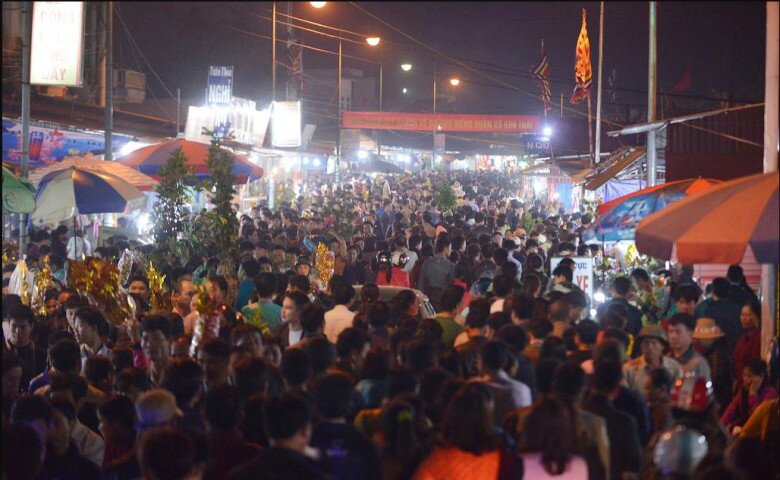
Hence, the word “Vieeng” in the market’s name implies “returning” or “gathering,” reflecting the reunion and convergence of people from far and wide. This unique fair, held only on the night of the 7th and the dawn of the 8th of the first lunar month, is believed to be a place to “buy luck and sell bad luck.”
What to Buy at Vieeng Market
Vieeng Market is not only special because of the time it is held or the concept of praying for good luck, but also because of the unique items sold there. Every year, thousands of people from all over flock to the Phu Day Relic Site to offer rituals to Saint Mau and visit Vieeng Market. Here, they buy beef, seedlings, artistic bonsai trees, and agricultural tools to bring home as gifts or blessings for their families and friends for the new year.
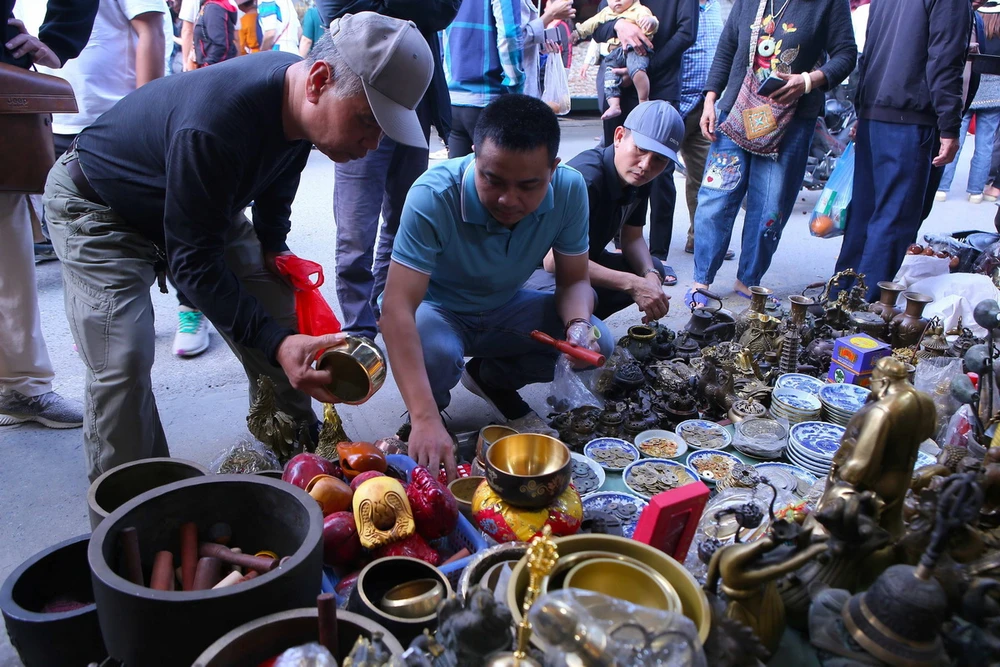
The products at Vieeng Market are diverse, ranging from baskets, sickles, shoulder poles, hoes, shovels, to bonsai trees and fruit trees. Locals believe that purchasing these tools at the beginning of the year will bring them a bountiful harvest and a prosperous life. Especially, beef is considered an offering to Mother Goddess Lieu Hanh, so buying beef here is seen as seeking her blessing. As for bonsai trees, buyers often choose trees with auspicious meanings, wishing for good fortune in the new year.
The goods at Vieeng Market are usually displayed in temporary stalls or even just laid out on mats. Handcrafted agricultural tools, shoulder poles, and baskets contribute to the distinctive character of this fair.
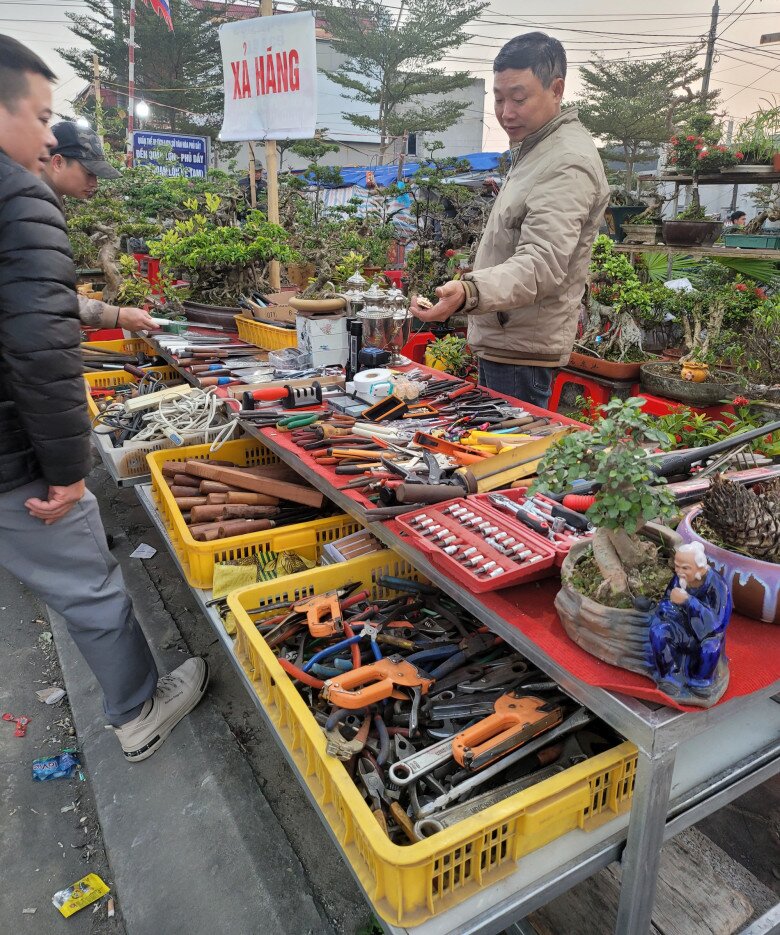
The roads leading to the central area of the market and Phu Day are often packed with people and vehicles. Despite the crowd, everyone is cheerful and excited about the fair atmosphere. Many even consider attending Vieeng Market as an unmissable annual event.
Apart from its spiritual significance, Vieeng Market is also an opportunity for the people of Nam Dinh province to promote their typical agricultural products of the Red River Delta and introduce their traditional cultural identities and socio-economic achievements to friends and visitors from all over the country.
Some Notes When Visiting Vieeng Market in Nam Dinh:
– Following the belief of “buying luck and selling bad luck,” visitors need not haggle over prices. Sellers also do not overcharge, as it is believed to bring good luck to both parties.
– The market is very crowded as it only takes place once a year. Although security has been tightened, visitors should still be cautious and vigilant to avoid pickpocketing or jostling.
– Parking and overnight accommodation near the market can be challenging. To avoid high parking fees or a lack of rooms, it is advisable to plan ahead for a smoother experience.
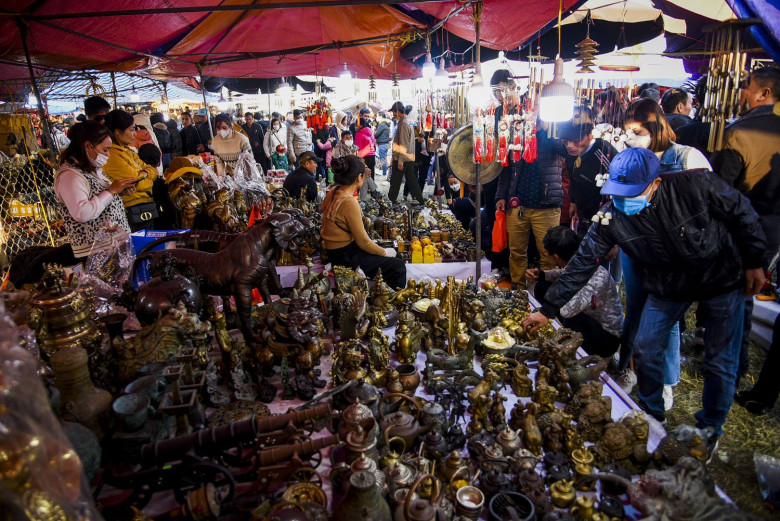
Vieeng Market has become an appealing tourist destination during the Tet holiday season. With its traditional ambiance, lucky charms, and festive atmosphere, Vieeng Market attracts not only locals but also visitors from all corners. By visiting Vieeng Market, tourists not only get to experience the unique cultural fair but also find joy and blessings of fortune and peace for the entire new year. It is truly a meaningful journey to start the year on a fulfilling note.
The Lucky New Year’s Market in Nam Dinh: A Unique Annual Tradition
For generations, the unique tradition of Viềng Market has been a beloved New Year pastime in Nam Định. This vibrant market holds a special place in the hearts of the locals, who flock to it with hopes of attracting good fortune and prosperity for the year ahead. It is believed that a visit to this market at the beginning of the year brings luck and sets the tone for a harmonious and bountiful year, filled with nature’s blessings.

